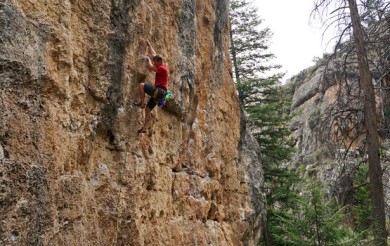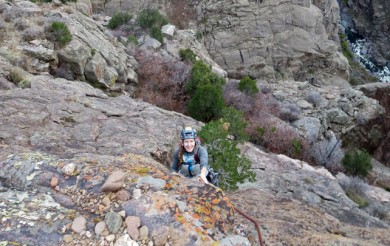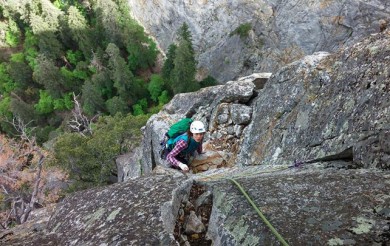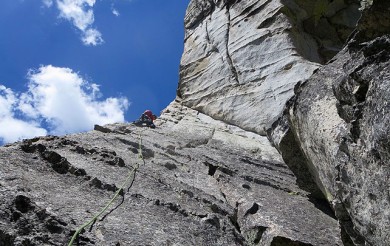Climbing Ethics vs Climbing Fun
 Last week I read the transcript of an interview with Jason Haas, who is writing a new guidebook to the South Platte in Colorado, and a certain quote really stuck out to me:
Last week I read the transcript of an interview with Jason Haas, who is writing a new guidebook to the South Platte in Colorado, and a certain quote really stuck out to me:
MB: You were talking earlier about some of your routes. Some of your routes could be said to be dangerous. And therefore, a lot of people won’t climb them. I interviewed a California first ascenter, and this gentleman came to the realization that he wanted people to climb his routes, so he started making them safer. What’re your thoughts on that, Jason?
JH: Well, I don’t have a problem with other people’s style. Maybe I’m, perhaps, a little too lazy to bolt myself. I just like the aspect of the unknown and the adventure side of things. So, that’s what works for me today. I’m a little bit younger and maybe, perhaps, a little bit dumber. So, I’m willing to take those risks right now. But, I’ve been climbing a lot in the South Platte lately, and replacing some bolts down there and working on a guidebook for there. And talking to some of the old first ascensionists, they kind of regret their run-out routes, because people aren’t repeating them. Looking back on that, 20/30 years later, [they] really wish that they had done them in a different style. So, I think there’s something to be said for that, of looking back on your routes.
(Thanks to ClimbingNarc.com for the heads up on this one.)
Because people no longer climb their routes, these guys in essence are saying they wish they’d made them safer. At some areas, old routes have been upgraded with better/more protection and have subsequently become popular classics, and I think this is a debate that’s going to come up more and more in the climbing world, especially as the old guard starts to fade. In some areas, like the South Platte & Tuolumne, you have massive resources of rock that are not being climbed, because the routes are simply too dangerous for the average recreational climber. Safer climbs at popular cliffs see lines on weekends, while these runout, usually slabby, affairs sit there fading into obscurity. And while there will always be a place for dangerous climbs that require you to rise to the occasion, the simple fact is that most climbers today pursue the sport as recreation, and as such are looking for safe venues in which to follow their passion.
My prediction would be that as this older generation passes on, at least some of these routes will be upgraded in a style that preserves the adventure aspect, but makes it more attainable to the climbing masses. Instead of a bolt every 30 feet, you might have them 15 feet apart, which is still plenty spicy by today’s standards, but would make the routes much more attainable. And guidebooks could even note the original style of the ascent, paying homage to a bygone era, so the masses could ponder those who had gone before and just how big their cajones must have been.
Now, I’m not saying I’m gonna go out and retrobolt anything, and I’m not endorsing the concept, I’m simply talking about a possible direction the sport could take, especially as it continues to become more popular and the need for more climbs increases.
What do others think? Am I way off base here? Will there always been staunch traditionalists who will defend these sacred testaments to climbing’s more dangerous past? Or will they remain obscure forever because most of them are slabs anyway, and slabs aren’t fun, or cool, and probably won’t be again any time soon?
8 Responses to Climbing Ethics vs Climbing Fun
Bulldog Creek Dog Walk (IV WI 4+)
Hayden Carpenter and Tom Bohanon recently repeated an obscure ice climb on the south side of Mt Sopris. Given a brief mention in Jack Robert’s ice guide, Bulldog Creek Walk is described as being 100 meters of WI 4. What they found was seven pitches of ice in a remote setting that makes for one […]
Connect with Us















Good topic for discussion BJ. Some old guy once said, climbing is more about the adventure, less about the sport. I bet he had some super run out routes that are still being done today… oh wait, he does.
Slabs not fun or cool? Since when?
I feel like there need to be scary runout routes around because there’s something to be said about being scared to death on a route, knowing that the potential to get hurt or die is very real and close, and then pulling through and climbing the thing. The feeling of accomplishment is a high rivaled by very few things I’ve experienced.
I think that this is a discipline of climbing that few people experience, but that doesn’t make it any less legitimate than a safely-bolted sport route. Why does one have the right to exist but another doesn’t? Is a safe sport route more deserving to be around than an “unsafe” one?
Does every route have to be climbable by every climber? There is enough rock out there for all tastes, abilities and styles. There’s some stuff out there that I’m just not ballsy or talented enough to get on, and I’m 100% OK with that. But then there are things that I get on that other people are not comfortable on.
It’s a tricky thing. Some people climb to have fun, others climb to be scared out of their minds. So what about when the first ascensionists condone adding bolts to make a route safer? Well, go for it, I guess? But I’m definitely not a fan of doing that without FA consent. An FA is art! You’re creating something beautiful that didn’t exist before. If someone else comes along and changes it, it’s like spraypainting a giant middle finger on the Mona Lisa.
But then of course that leads to the question of whether or not the first ascensionsts “own” the route. Just because they climb something before someone else, does that give them the right to dictate how everyone else after them climbs it? I don’t know. Climbing is an inherently selfish pursuit, I think, and that makes it difficult when you’re dealing with something that will affect a lot of people other than you.
Great points Tristan. I think the community ultimately needs to make the decision, and I don’t think the FA owns the route in any way whatsoever. It’s mostly public land we’re talking about here, and that means majority rules.
In my mind it depends largely on the nature of the route as far as whether or not I’d be okay with it being super runout. For example the majority of the line at the Red River Gorge are so overhanging that a runout route might be pretty fun there just to add some spice. I have to admit I love whippers, but there’s a major difference when you’re taking a whipper into basically all air or if you’re on a vert/slab route and are going to come back down hard on your ankles. Maybe I lack the old school hardcore mentality, but after being injured enough times, I have become a lot more conscious in what I’m willing to risk. I would say that’d I’d be okay with long runouts on a 10a, but then again even though I’ve never fallen on a 10 I have a very high tendency to get injured on routes/problems that I consider to be warm-ups/easy onsights so taking Murphy’s law into account, I’d probably be that guy to break both of his legs on a fumbled clip up a heavily runout 5.7.
It seems to me like a runout sports route is almost pointless. Why do you bolt a sport route to be runout? Did they do it for it to be scary, or because they were cheap and didn’t feel like adding more bolts (which, given the price of bolts, is fine, I guess)? The person who does the FA does not necessarily own the rock. It was there before they got there, and it will be there after they die. Runouts on trad climbs are natural, because that’s just the way the rock is, but runout on sport climbs is artificial, because it’s simply an effect of the unnatural process of bolting rock. It is not something inherent to the cliff face.
That said, I would say that if you wanted to rebolt a climb, you should do whatever you can to talk to the FAer first. Not because he owns the rock, but out of respect and courtesy for someone who led the way on a cliff. For old obscure routes that no one knows who FAed, maybe there is more leeway. I am, however, a great respecter of tradition, and I don’t think anything should be rebolted just because you feel like it. There should be a purpose.
I do agree with Tristan that there is plenty of rock out there for everybody at every level, and to rebolt every route that is considered scary would be sad and turn climbing into more of a yuppie sport. A little fear is a good thing. But rebolting a route should not be considered a heinous crime the way many climbers look at it. Sorry if I sound a little contradictory, but I think you get my point.
Pingback: Do First Ascentionists Own The Rock? : Splitter Choss
I say make the routes fun and safe. Climbing is still dangerous and exciting even if you are not terribly run out. Bold leads are thrilling, but perhaps there is a balance as the author mentioned of 15 or so feet between bolts.. and if there are too many bolts for you to feel like a man just skip some. Then everyone can get their way, right?